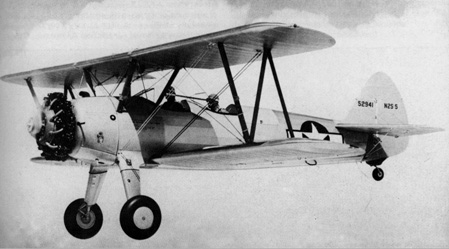Boeing/Stearman Model 75/PT-13/N2S


The Stearman Aircraft Company designed a new primary trainer for the U.S. Army Air Corps in 1933. It was, however, the U.S. Navy which was the first service to express an interest; and in 1935 ordered the first models under the designation NS-1; later Navy versions were known as the N2S. The USAAC began receiving theirs in 1936, under the designation PT-13. In 1939 Stearman became part of the Boeing Airplane Company. The Boeing/Stearman division produced modified later versions under the names PT-17, PT-18, and PT-27. The most common names for this aircraft remain the Model 75 Stearman, the PT-13 to the USAAC, and the N2S to the U.S. Navy. The unofficial nickname for the aircraft was the Kaydet. But whatever you called it, the stable and forgiving "Stearman" was an important part of American aviation primary training, and became a fond part of many U.S. aviator's memories. After the war many were sold as surplus, and large numbers became crop dusters. Quite a few survive today as privately-owned collector's items.
Additional information on this aircraft
can be found at Wikipedia
here.
(updated February 2009)
Boeing / Stearman Model 75 (Kaydet) / PT-13 / N2S
Type: two-seat primary trainer
Crew: 2: pilot, trainee
Armament: none
Specifications:
Length: 25' 0.25" (7.63 m)
Height: 9' 2" (2.79 m)
Wingspan: 32' 2" (9.80 m)
Wing area: 297 sq. ft (27.59 sq. m)
Empty Weight: 1936 lb (878 kg)
Max Weight: 2717 lb (1232 kg) max at takeoff
Propulsion:
No. of Engines: 1
Powerplant: Lycoming R-680-17 radial
Horsepower: 220 hp
Performance:
Range: 505 miles (813 km)
Cruise Speed: 106 mph ( 171 km/h)
Max Speed: 124 mph ( 200 km/h)
Ceiling: 11,200 ft (3415 m)
If this page does not have a navigational frame on the left, click HERE to see the rest of the website.